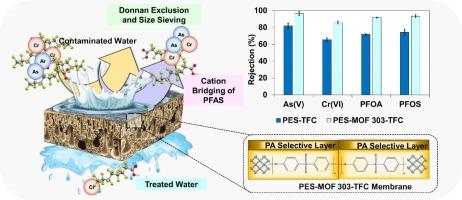Tailoring nanofiltration membranes with MOF 303 modified support layer for enhanced PFAS and heavy metal separation
IF 9.8
1区 工程技术
Q1 ENGINEERING, CHEMICAL
引用次数: 0
Abstract
Per- and polyfluoroalkyl substances (PFAS) are persistent synthetic chemicals extensively used in industrial and consumer products, posing significant environmental and health concerns. The PFAS and metal-contaminated water serve as a primary source of human exposure, necessitating effective remediation strategies. In this study, we developed a nanofiltration (NF) membrane by integrating an aluminum-based metal-organic framework (MOF 303) into a polyethersulfone (PES) support layer, followed by the fabrication of a selective polyamide layer, and tested its performance for PFOS, PFOA, As(V), and Cr(VI). The resulting PES-MOF 303-TFC membrane exhibited excellent performance, achieving pure water permeance of 11.68 ± 1.34 LMH bar-1, approximately 1.5 times higher than the pristine PES-TFC membrane and a Na2SO4 salt rejection of 87.16 ± 3.14 %. It demonstrated robust rejection rates of ∼92 % for PFOA and 93 % for PFOS in simulated groundwater, alongside the effective removal of As(V): ∼97 % and Cr(VI): ∼86 % in a cross-flow mode of operation. The membrane maintained over 92 % rejection of PFOA and PFOS in a simulated secondary-treated wastewater matrix. These results highlight the dual electrostatic repulsion and size exclusion mechanisms of the PES-MOF 303-TFC membrane, offering a versatile, high-performance solution for remediating groundwater contaminated with PFAS and heavy metals. Our findings emphasize the promise of NF membranes with tailored properties for addressing emerging water contamination challenges.

剪裁纳滤膜与MOF 303改性支持层,以增强PFAS和重金属分离
全氟烷基和多氟烷基物质是广泛用于工业和消费品的持久性合成化学品,对环境和健康构成重大关切。PFAS和金属污染的水是人类接触的主要来源,需要有效的修复策略。在本研究中,我们将铝基金属有机骨架(MOF 303)集成到聚醚砜(PES)支撑层中,然后制作了选择性聚酰胺层,开发了纳滤(NF)膜,并测试了其对全氟辛烷磺酸、全氟辛烷磺酸、砷(V)和铬(VI)的性能。制备的PES-MOF 303-TFC膜表现出优异的性能,其纯水渗透率为11.68±1.34 LMH bar-1,是原始PES-TFC膜的1.5倍,Na2SO4的去除率为87.16±3.14%。它显示出模拟地下水中PFOA的截除率为~ 92%,PFOS为93%,同时在横流操作模式下有效去除As(V): ~ 97%和Cr(VI): ~ 86%。该膜在模拟的二级处理废水基质中保持了92%以上的PFOA和PFOS的去除率。这些结果强调了PES-MOF 303-TFC膜的双重静电排斥和尺寸排除机制,为修复受PFAS和重金属污染的地下水提供了一种多功能,高性能的解决方案。我们的研究结果强调了具有定制特性的NF膜在解决新出现的水污染挑战方面的前景。
本文章由计算机程序翻译,如有差异,请以英文原文为准。
求助全文
约1分钟内获得全文
求助全文
来源期刊

Desalination
工程技术-工程:化工
CiteScore
14.60
自引率
20.20%
发文量
619
审稿时长
41 days
期刊介绍:
Desalination is a scholarly journal that focuses on the field of desalination materials, processes, and associated technologies. It encompasses a wide range of disciplines and aims to publish exceptional papers in this area.
The journal invites submissions that explicitly revolve around water desalting and its applications to various sources such as seawater, groundwater, and wastewater. It particularly encourages research on diverse desalination methods including thermal, membrane, sorption, and hybrid processes.
By providing a platform for innovative studies, Desalination aims to advance the understanding and development of desalination technologies, promoting sustainable solutions for water scarcity challenges.
 求助内容:
求助内容: 应助结果提醒方式:
应助结果提醒方式:


